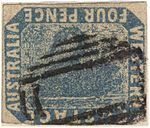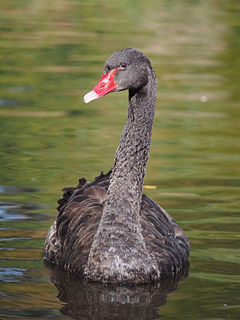
Stamp collecting is the collecting of postage stamps and related objects. It is related to philately, which is the study of stamps. It has been one of the world's most popular hobbies since the late nineteenth century with the rapid growth of the postal service, as a never-ending stream of new stamps was produced by countries that sought to advertise their distinctiveness through their stamps.

The Inverted Jenny is a 24 cent United States postage stamp first issued on May 10, 1918, in which the image of the Curtiss JN-4 airplane in the center of the design is printed upside-down; it is probably the most famous error in American philately. Only one pane of 100 of the invert stamps was ever found, making this error one of the most prized in all philately.

The Penny Red was a British postage stamp, issued in 1841. It succeeded the Penny Black and continued as the main type of postage stamp in the United Kingdom of Great Britain and Ireland until 1879, with only minor changes to the design during that time. The colour was changed from black to red because of difficulty in seeing a cancellation mark on the Penny Black; a black cancel was readily visible on a Penny Red.

Postage stamps and postal history of Great Britain surveys postal history from the United Kingdom and the postage stamps issued by that country and its various historical territories until the present day.
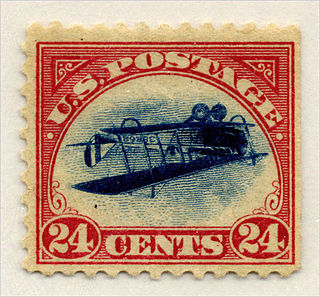
In philately, errors, freaks, and oddities (EFO) refers to all the kinds of things that can go wrong when producing postage stamps. It encompasses everything from major design errors to stamps that are just poorly printed and includes both some of the most sought-after and expensive of all stamps and others that attract the attention of only a few specialists.

The 2¢ Large Queen on laid paper is the rarest postage stamp of Canada. Printed in 1868, it was not discovered until 1925, and so far only three have been found, all used. Many more could exist as at least one sheet must have been printed, and possibly many sheets; however, they may all have been destroyed, or lie unrecognised in stamp collections or on cover.

The British Guiana 1c magenta is regarded by many philatelists as the world's most famous rare stamp. It was issued in limited numbers in British Guiana in 1856, and only one specimen is now known to exist. It is the only major postage stamp ever issued that is not represented in Britain's Royal Philatelic Collection.
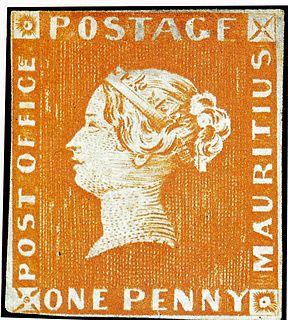
The Mauritius "Post Office" stamps were issued by the British Colony Mauritius in September 1847, in two denominations: an orange-red one penny (1d) and a deep blue two pence (2d). Their name comes from the wording on the stamps reading "Post Office", which was soon changed in the next issue to "Post Paid". They are among the rarest postage stamps in the world.

The "Nixon invert" was a reputed invert error of the Richard Nixon memorial postage stamp issued by the United States in 1995. Originally reported in January 1996, it drew considerable attention that year; but in December a printing plant employee was arrested on charges of having stolen the misprinted stamps from the plant where he worked, meaning that instead of a legitimate error, they were worthless printer's waste.
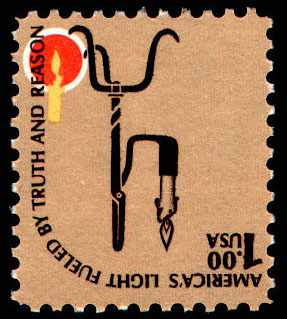
The CIA invert is a one-dollar value postage stamp error issued by the United States Postal Service. It is one stamp from the Americana series that were produced between 1975 and 1981. The $1 colonial rushlight holder stamp was first issued on July 2, 1979 and one pane of 100 stamps was issued with the dark brown inverted. The lamp candle holder, candle outline and text are inverted relative to the flame. About 95 copies have been accounted for. The Scott catalogue number is: 1610c. This was the first United States stamp issued with a major design element printed upside down since the Dag Hammarskjöld invert error of 1962. As these $1 stamps were printed in sheets of 400, three additional panes of 100 stamps certainly existed at one time, but no trace of these has so far been discovered.

The Dag Hammarskjöld invert is a 4 cent value postage stamp error issued on 23 October 1962 by the United States Postal Service one year after the death of Dag Hammarskjöld, Secretary-General of the United Nations, in an airplane crash. The stamp, showing the yellow background inverted relative to the image and text, is also known as the Day's Folly after Postmaster General J. Edward Day who ordered the intentional reprinting of the yellow invert commenting, "The Post Office Department is not running a jackpot operation."

The Inverted Head Four Annas of India is a postage stamp prized by collectors. The 1854 first issues of India included a Four Annas value in red and blue. It was one of the world's first multicolored stamps; the Basel Dove preceded it by nine years. However, an invert error occurred during production, showing the head "upside down."

The Baden 9 Kreuzer Error is a postage stamp error produced by the historical German state of Baden in 1851.
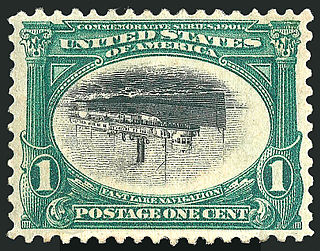
As part of the Pan-American Exposition held in Buffalo in 1901 the United States Post Office Department issued a series of six commemorative stamps. Each stamp featured an ornate colored frame enclosing a black-and-white image of some means of modern rapid transportation. In the standard American Scott catalog, these six stamps carry the numbers 294-299. The first day of issue for the stamps was May 1, 1901.
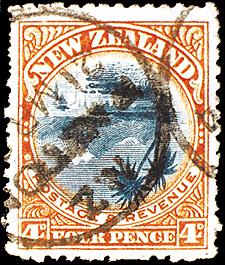
The 1904 Pictorial 4d Lake Taupo invert is a postage stamp error considered to be the rarest New Zealand stamp. The centre vignette is inverted in relation to the outer frame. The stamp was discovered in a schoolboy album in 1930 and no other copy has been found since then.

Western Australia, a state of Australia and formerly a British colony, established its postal service soon after the British settled in 1829; in December of that year, Fremantle's harbourmaster was appointed postmaster. A post office in Albany opened on 14 October 1834, and the main post office moved to Perth in 1835.

The British Library Philatelic Collections is the national philatelic collection of the United Kingdom with over 8 million items from around the world. It was established in 1891 as part of the British Museum Library, later to become the British Library, with the collection of Thomas Tapling. In addition to bequests and continuing donations, the library received consistent deposits by the Crown Agency and has become a primary research collection for British Empire and international history. The collections contain a wide range of artefacts in addition to postage stamps, from newspaper stamps to a press used to print the first British postage stamps.

The Tapling Collection of postage stamps was donated to the British Museum from the estate of Thomas Tapling in 1891.
